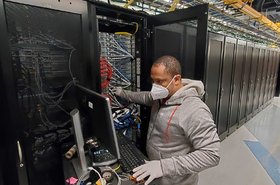Over the past six months, major cities have witnessed a ‘mass exodus’ as many offices and company HQs were left over-priced and under-used in the wake of the coronavirus outbreak. Whilst some employers had already adopted a flexible approach to working from home, the pandemic forced the hands of those more reluctant to make the move to remote working.
With over 50 percent of employees expecting to never return to the office full-time, never-before-seen levels of bandwidth and connectivity are required to maintain productivity from homes around the country. As a result, demand has shifted firmly away from the need for low latency and data centers which are close to end users in major cities. Instead, we are seeing a strong uptick in the need for the scalability and flexibility that hyperscale facilities offer.
So, does this spell the end for the edge? Has the pandemic spurred us all onto to the age of hyperscale?
Falling off the Edge
Not too long ago, localized edge data centers were an ideal solution to companies based in major cities. The close-proximity of edge centers to the end user provides the ability to increase the speed of operations, which is especially important in industries such as financial trading and gaming, where reduced traffic and quick response is key.
However, the recent surge of employees working from home, often in more rural areas and second-tier towns, means that the need for connectivity is no longer exclusive to large cities. Instead, there is a new demand for flexibility, in terms of where, and when employees can work and connect.
The pandemic has not only affected how employees work, but also the priorities of companies at large – scalability being a new must-have element of many companies’ business plans. Edge data centers lack this ability to be quickly adapted, leaving businesses’ who continue to use edge vulnerable to paying for unneeded space and staff in an economic downturn, and equally sub-optimal reactivity in the face of opportunity.
Out with the old
This shift in business priorities was not necessarily caused by the pandemic, but was certainly cemented by it. Employees were already calling for more flexible working. Employers were already considering migrating from high-cost cities to more affordable office locations. The need for close-proximity data centers was already on the decline, the pandemic has merely sped up the process.
With 58 percent of IT leaders placing faster delivery of IT services in their top three priorities of 2020, it is no wonder that the ability to expand exponentially and respond rapidly that hyperscale centers offer began to overshadow the limited parameters of edge centers in recent years. Hyperscale offers a permanent solution to the increased speed that modern businesses demand, which edge data centers were not built to keep up with.
In with the new
The future for business is full of uncertainty, but if this really is the ‘new normal’, then future-proofing needs to be the top priority for every organization. Hyperscale offers businesses the flexibility and scalability to deal with any situation that comes their way – whether this may be a second wave of shut-downs or a shift to permanent remote working.
The shift towards hyperscale has been a long time coming. We saw major players such as Google, Facebook and Amazon make this move years ago, and uptake has only increased since, showing no signs of slowing down in the years to come. The reason for this shift is clear. Hyperscale data centers facilitate large-scale cloud adoption. The pandemic has forced organizations across verticals to recognise the multitude of benefits that the cloud offers. From faster time-to-market and simplified innovation to easier scalability, and reduced risk, cloud adoption can benefit businesses immensely, particularly in the current climate. As businesses continue to accelerate their transition to the cloud, the demand for hyperscale will continue to pick up speed.
Scalability is another reason why hyperscale uptake has gathered pace in recent times. When it comes to scalability, the rhetoric is always about growth and expansion. However, a vital, yet often overlooked, aspect of scalability is the opportunity to scale down when needed. In the immediate, for businesses looking to protect themselves in their recovery process post-pandemic, this will be invaluable. Hyperscale facilities offer businesses just that – the flexibility to operate like an elastic band, expanding or downsizing when necessary and at a moment’s notice.
Looking forward, demand for edge data centers can be expected to only decline further, with only a handful of verticals continuing to benefit from the low latency they offer. In order to be ‘future-proof’ as we move into a post-pandemic world, the vast majority of businesses will consider how to ensure their operations are viable and efficient in the ‘new normal’. Only hyperscale data centers are able to offer the flexibility, scalability and far-reaching connectivity necessary to achieve this.





